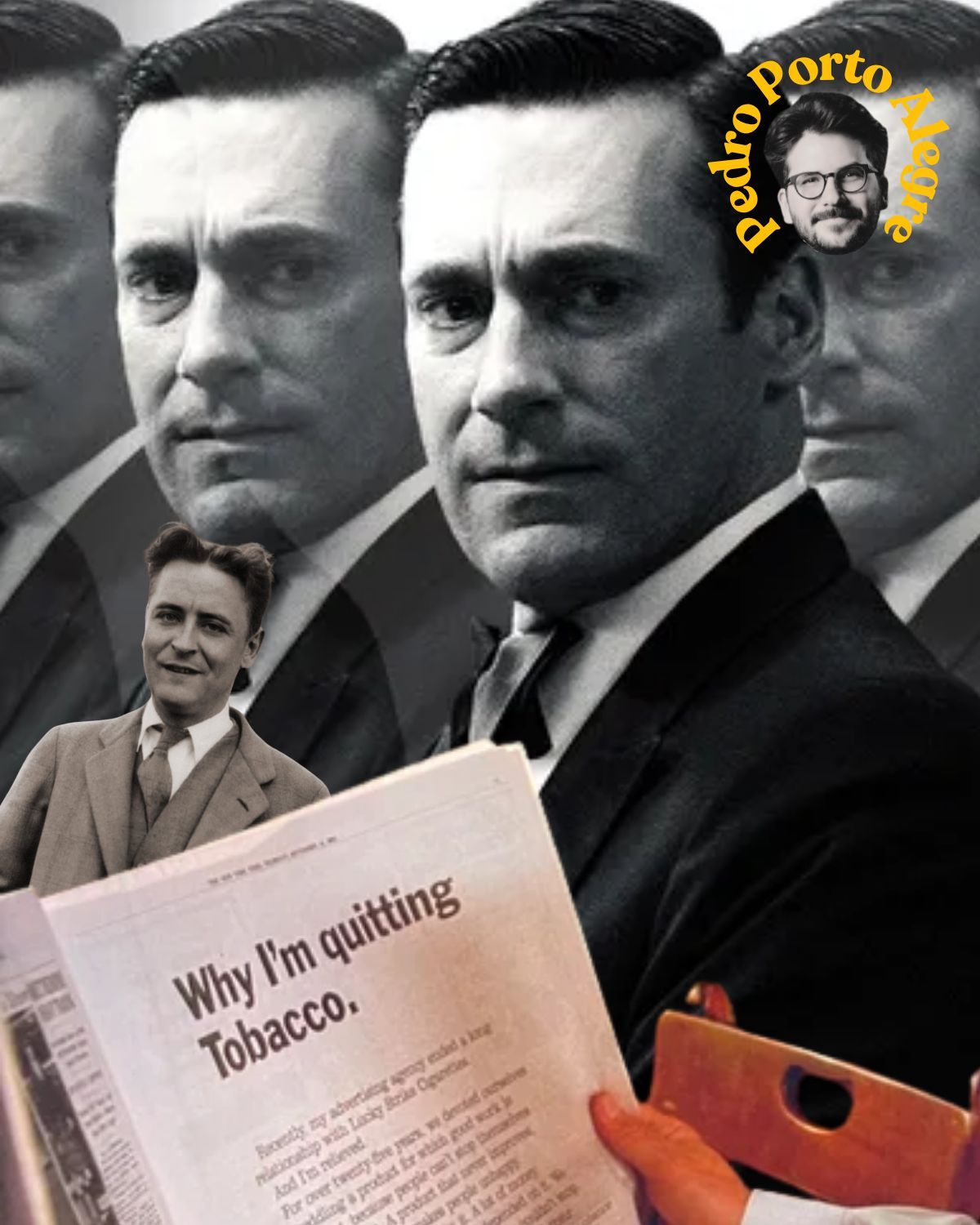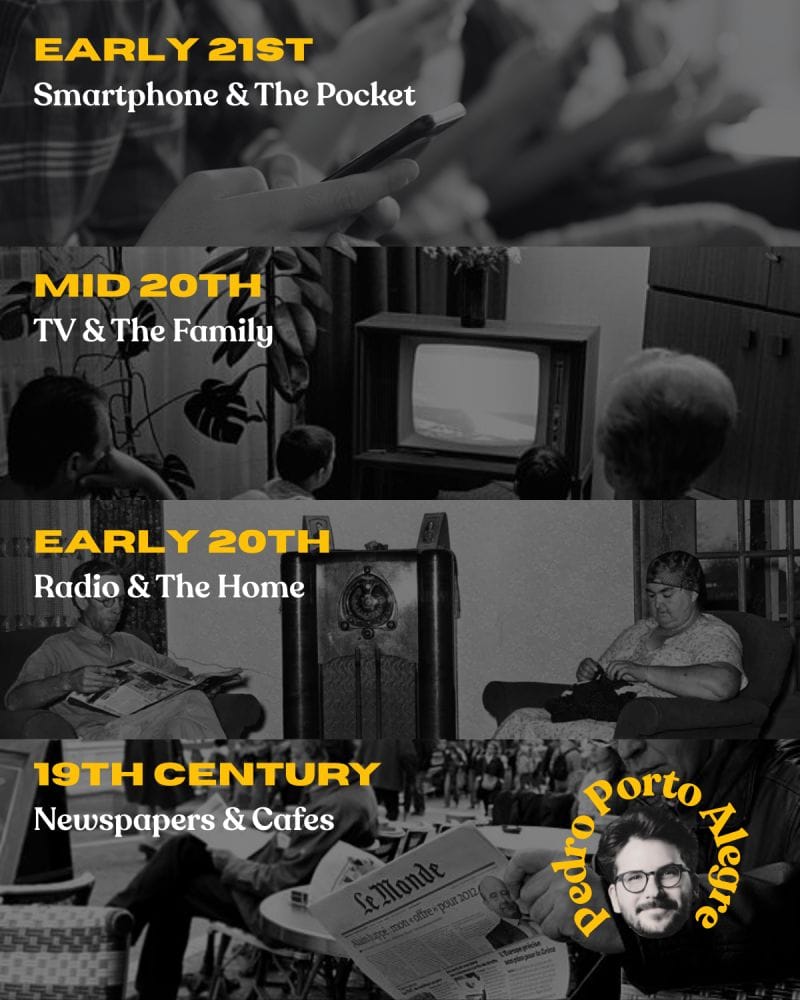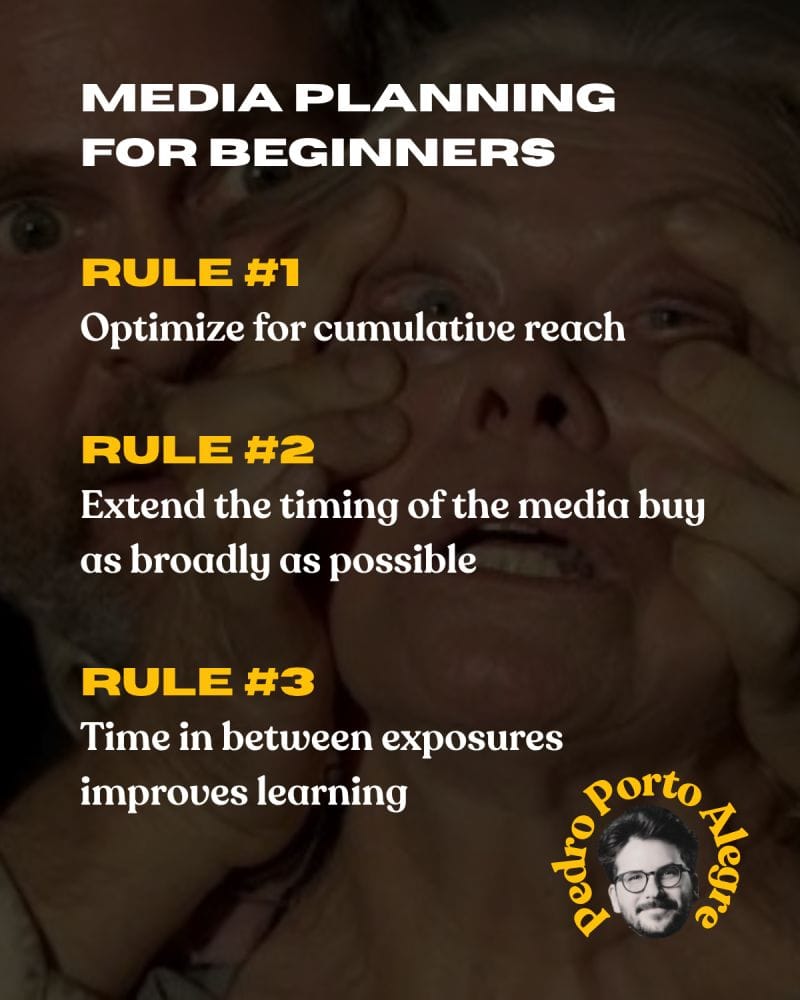- Marketing Chronicles
- Posts
- How Culture Has Been Shaped By Media
How Culture Has Been Shaped By Media
Laws of Retail, cowboy culture, cardinal rules of media planning, and a new age fit for generalists
Welcome to Marketing Chronicles. A monthly dose of strategy and creativity for brands, agencies, and businesses — delivered on the second Wednesday of every month. If you like what you see and you’re not already a subscriber, join us for free.
Hello Marketing Chroniclers. This month I’m introducing a new form of content that I’ve been dabbling with: video. I upload all of them to my LinkedIn and Instagram accounts, but below are a few I’ve recorded as of late that I think you’ll enjoy.
Drop me a line on LinkedIn if anything stands out to you!
Enjoy 🧠
This edition is supported by Tracksuit, a beautiful, affordable, always-on brand tracking dashboard that helps marketers and agencies prove the impact of brand building.
I’ve always found that setting SMART brand objectives to be difficult without having a clear baseline of where my brands stand — until now. The folks over at Tracksuit have developed an elegant tool that helps you understand how your activities are impacting your brand's health metrics without breaking the bank.
BUILDING BASKET/
Shoppers Only Spend A Constrained Amount Of Time In Store
Loyalty programs should actually be called basket programs. Because in reality, their ability to improve loyalty is pretty limited.
The Ehrenberg-Bass Institute has an entire corpus of work that details empirically why that's the case (spoiler alert: loyalty is a consequence of market penetration, and for the most part doesn't differ all that much between category players).
However, several loyalty players have observed basket sizes being significantly larger among loyalty members vs non-loyalty members.
Therefore, if you're a business rolling out a loyalty program your measurement of success for the program shouldn't be improving frequency of purchase (most buyers are light buyers anyway), but instead the degree to which basket size is larger versus non-loyalty members.
And the reason for this is quite simple: there are empirical laws of shopping that have been observed across markets, channels, and time periods that hold true no matter what - and one of them is that shoppers have an "internal clock" of how much time they're willing to spend in a store.
Meaning, if they find what they're looking for right away, they'll spend the remainder of their "internal timer" browsing; if it takes them the entire time to find what they're looking for then they’ll sprint to the till to get out of there.
So, if you have a loyalty program, personalizing offers based on purchase history effectively enhances this "speed to shop" and enables the retailer to drive basket-size by layering on other products that are relevant to the shopper.
It's a small nuance, but it can completely reframe how an organization sees their program and how to make the most of it.
COWBOY CULTURE/
A Push Back Against The “Flattening” of Culture
Cowboy culture has made an incredible comeback over the past 5 years. And we're seeing this reflected at the The Calgary Stampede's attendance numbers. But what's the underlying force pushing this to the surface?
I was recently going through some of my book highlights, and encountered this gem from David Coggins' book "Men and Style: Essays, Interviews and Considerations":
"The line separating authenticity from posturing is very fine. This all leads to a friction without end, and it defines the contours of the culture."
Meaning, not everyone can be a cowboy, but everyone can find authentic ways of tapping into the underlying current bringing it back to the fore.
Or as Jasmine Bina so elegantly described in her Psychotechnology presentation, trends are manifestations of underlying big ideas.
And big ideas are not fleeting - they tend to last and be more universal.
Which is why my assessment of Western culture being back in vogue, country music once again dominating the charts across audiences, and TV shows pulling us back into the friction of "rural life", is about one dominant overarching idea:
A push back against the flattening of culture driven by technology over the past 15 years.
Which brands do you think are doing a good job at pushing back against this "frictionless" tech-forward experience that has been present in culture as of late?
SKILLS DEPT/
Empathy Still Remains The Most Underrated Skill For Marketers
One of the most underrated skills a marketer should be exceptional at is empathy. While big marketing organizations have started "training" their teams on it, this is something that's just so difficult to teach.
As marketers, our biggest job is to be the voice of the consumer inside the organization. That means, we're not here to judge them - we're here to understand them.
For example, political populism is obviously on the rise, and at its core it's a movement about the rejection of institutions and the elites (and to some extend, institutionalized expertise), that people feel have failed them.
We see this undercurrent also showing up in culture: the rise of decentralized media such as Substack and Patreon, anti-fashion trends like upcycling, alternative wellness movements such as psychedelic therapy, punk and underground rap becoming popular again, tech utopianism with the rise of web3 and crypto, and so on .
Now, you can agree or disagree with this undercurrent - but as a marketer, even if you're a staunch traditional conservative who believes in the power of institutions, your job isn't to judge your consumers - instead, it's to find a way for your brand make a contribution to its communities and capitalize on what's relevant within them so you can grow the business.
This isn't the same as supporting disingenuous causes - even Don Draper took a stance against tobacco (even if it was mired by secondary intentions). But you should be able to separate the signal from the noise and understand what's moving your consumers today.
F. Scott Fitzgerald put it perfectly: "The test of a first-rate intelligence is the ability to hold two opposed ideas in the mind at the same time, and still retain the ability to function."
Or, as Les Binet put it recently more colourfully: "Stop thinking like a marketer. Start thinking like an ordinary person. Clear away some of the f*cking bullsh*t in what we do."

PREDICTIONS/
We’re Entering A New Age Fit For Generalists
Most of the things we're experiencing today in society, business, and in our personal lives can be traced back to some sort of classical work of literature or philosophy.
I believe we're headed to a fascinating time in history that will resemble a lot like to Renaissance.
But no, I don't think that technology is ushering in a "golden age". Rather, I see an entire generation that has been corralled into a specialty (i.e.: data analytics, digital marketing, petroleum business management, etc.), now having to think more like generalists.
With AI tools being able to accomplish most specialized work at very advanced levels (and continuing to get better every day), thinking more fundamentally about things could very easily become a super power.
Seeing the big picture, identifying patterns, connecting disparate ideas, asking great questions, making smart predictions, etc. are all skills that generalists are really good at.
Which is why I believe reading the classics will give a leg up to strategists looking to flourish in this quickly changing environment.
As Mark Twain once said: "History never repeats itself, but it does often rhyme."
HISTORY/
How Culture Has Been Shaped By Media
Didn't people used to look so cool reading the newspapers at French cafes? Well, that wasn't necessarily by choice - and it hints at how media has shaped the cultural industry around us.
Back in the 19th and early 20th centuries, most people couldn't afford a personal newspaper subscription.
So cafes started to offer shared access to newspapers for the price of a cup of coffee - going as far as creating reading rooms called "salles de lecture".
But that wasn't the end of it - cafes also ended up becoming cultural hubs for reading and debating politics, and often where revolutionaries would gather to discuss society and culture.
Then came the radio. In the first half of the 20th century, for the first time the cultural industry was brought into the home.
This led to a decline in café-based news culture, and accelerated the flow of information from daily to closer to real-time (sound familiar?).
After WWII the television added a transformative layer to this whole landscape, and basically dominated for the remainder of the 20th century, until the internet started to take hold.
But what's interesting about TV is that people could now see footage of their news and cultural interests from the comfort of their homes. Up until that point things were either print or audio - thus opening up the cultural industry to a whole new dimension of possibilities.
This further entrenched people into the home, where families would gather around the TV to watch the news, talk shows, and historical events like the Moon landing.
The latest transformation of how culture disseminated in society came in the late 2000s, with the advent of the smartphone.
Now people could take the cultural industry in their pockets wherever they went. The pace at which information travelled dramatically accelerated, and with the added layer of social media, culture further fragmented itself into little pieces.
I find studying the history of media to be a great way to understand some of the bigger currents of cultural change.
Culture depends on the dissemination of information at scale, so media channels become major players in shaping how we interact, and how the units of culture we trade amongst ourselves morphs to fit the medium.

MEDIA DEPT./
The 3 Cardinal Rules Of Media Planning
I'm no media planner, but I find that strategists in independent agencies are asked more and more to provide their initial opinions around how a campaign should go to market from a media standpoint to help creatives and the client grasp the task at hand - particularly when working with small to medium sized businesses.
So, here are some "rules of thumb" I've used over the years to facilitate those initial discussions before bringing in a proper a media planner to create the plan.
These are oversimplified for the sake of understanding, and don't come anywhere near the level of detail and insights that a media planner can bring to the table. So, never take your brand strategist's media recos as gospel, unless you don't have the money to pay for a media planner.
Rule 1: Optimize for cumulative reach Evidence shows that advertising greatest's effects happen when an individual goes from 0 to 1 exposure. Additional exposures have lesser effects than the first one - so optimize media choices for total reach first, before thinking about frequency (particularly when talking about brand campaigns).
For example: if we have the budget, chances are TV is the best "core" media channel for any campaign, but then the second media channel I'd choose would have to provide the biggest additional reach over those who may not have been hit by the TV spot. Inevitably there will be overlap, but you want to minimize that as much as possible - in this case, OOH typically is the best next choice. And so on.
Rule 2: Extend the timing of the media buy as broadly as possible It's hard to predict when consumers will enter the category to buy. Most of them (~95%) are out of market at any given time. Since media effects increase the closer to the moment of truth one gets (i.e.: seeing a potato chip display at a grocery store), you want to maximize your chances that your brand will be seen at any given time.
While at lower budgets this means that at any given week less people will see your ad/brand, by being "always on" you increase your chances of being seen by consumers who are entering the market throughout the year.
Another way to look at it is by daypart if you're a CPG brand:
In the morning: newspapers; On the way to work: OOH; At work: social media; At home: TV.
Rule 3: Time in between exposures improves learning Sometimes, repetition is important to form new memory structures (as opposed to refreshing old ones). Evidence has shown that longer intervals between exposures result in better learning (up to 20% improvement in memory than shorter intervals).
This means that varying the context of your ad (i.e.: TV before bed vs OOH on the way to work) can become a powerful way to improve brand recall.
Of course, these "rules" are just starting points (derived from the Ehrenberg-Bass Institute). But this simple framework has helped me bringing to life strategies for creatives and clients as we move along the process.

INSPIRATION/
The Rewards Bag
If you are like me, you probably have an ever growing stack of cloth grocery bags stacking up somewhere in your kitchen.
Since plastic bags were outlawed in Canada (and other places around the world), shoppers have been expected to bring their own bags to shop.
But the problem is that we often forget to bring them, and end up buying new ones with each and every trip.
So, how do you help solve this problem while also propping up your store’s loyalty program?
Turn the bag into a scannable loyalty card.
BRAIN FOOD/
Strategist’s Delight (What’s On)
Book: Minima Moralia: Reflections on a Damaged Life (Theodor W. Adorno)
Podcast Episode: Why Advertising Is Broken & How To Fix It w/ Tom Goodwin (Uncensored CMO)
TV Series: American Primeval (Netflix)
Film: Jurassic World: Rebirth (Theatres)
QUOTE/
Playing The Game On “Easy Mode”
“ Having a great brand means you get to play the game of capitalism on easy mode.”
More of PPA:
🗣 For speaking engagements, you can reach me at [email protected]
💌 In case you missed it: Why Obsessing Over Efficiency Is Killing Your Brand — Aesthetic nihilism, Justin Bieber's newest brand, unsh*ttifying CX, and brands that matter
PPA
Pedro Porto Alegre is a seasoned marketing strategist with in-depth experience building brand and communications strategies for top-tier B2C and B2B organizations across North America. His repertoire extends from crafting and executing integrated multi-media brand marketing campaigns to the commercialization of performance-driven innovations for multimillion-dollar and nascent brands alike.







